Top 9 Best Knowledge Base Examples Tips in 2025
Explore how top companies leverage knowledge bases to empower users and reduce support tickets. Discover various knowledge base examples and types. Gain inspiration in the blog to craft your own.

Explore how top companies leverage knowledge bases to empower users and reduce support tickets. Discover various knowledge base examples and types. Gain inspiration in the blog to craft your own.

Are you looking to expand your knowledge base but not sure where to start? Whether you’re a student, professional, or just someone eager to learn, having a strong knowledge base is essential. It is helpful in both personal and professional growth.
There are countless resources available that can help you build your knowledge base. It can be overwhelming to navigate through all the options. 88% of customers expect a company to have an online self-service knowledge base.
We will explore some knowledge base examples that can serve as a starting point for your learning journey. Whether you’re interested in expanding your expertise or simply want to broaden your horizons, the examples will guide you towards achieving your goals.
A knowledge base refers to a centralized repository of information that is used to store and organize knowledge within an organization. It typically includes articles, documents, guides, FAQs and other resources that provide information to users. Knowledge bases can be used for a variety of purposes such as training, troubleshooting, customer service and internal knowledge sharing.

Knowledge bases are essential tools for businesses looking to streamline their operations, improve service and empower employees with the information they need to succeed. Creating an effective knowledge base can help organizations ensure that information is accessible across all channels. It not only improves efficiency but also enhances the customer and employee experience.
You can improve efficiency, productivity and customer satisfaction within your organization by creating a knowledge base. The article explores the many benefits of creating a knowledge base and how it can help streamline your business operations.
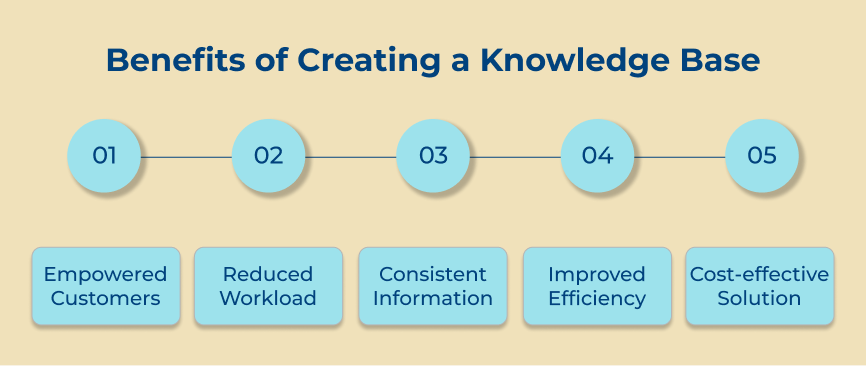
A well-designed knowledge base empowers customers by providing them with immediate access to relevant information and solutions. It enables customers to find answers to their questions independently, without the need for direct assistance from support staff. The self-service approach not only enhances customer satisfaction but also enhances a sense of control.
Organizations can significantly reduce the workload on their support teams by offering a comprehensive knowledge base. When customers can find answers to common queries on their own, the number of support tickets and inquiries decreases. The reduction in workload allows support staff to focus their efforts on more complex or escalated cases, thereby increasing their productivity.
A centralized knowledge base ensures that customers and employees receive consistent information across all channels. Organizations can eliminate the risk of providing conflicting or outdated information by maintaining a single source of truth. It can lead to confusion and frustration. The consistency enhances the customer experience and promotes trust in the organization’s expertise.
A well-organized and searchable knowledge base streamlines the process of finding information, leading to improved efficiency across the organization. Instead of spending time searching through sources, employees can quickly locate the information they need within the knowledge base. The increased efficiency translates into faster problem resolution.
Implementing a knowledge base can be a cost-effective solution for organizations, particularly in the long run. Reducing the workload on customer service teams can help organizations potentially decrease the need for additional support staff and associated costs. A knowledge base can minimize the expenses associated with customer support, such as phone calls, emails and live chat sessions.
A knowledge base is a centralized repository of information that can be accessed and utilized by individuals within an organization or customer base. Knowledge bases are incredibly versatile tools that can be used for a wide range of purposes. We will explore 9 great knowledge base examples.
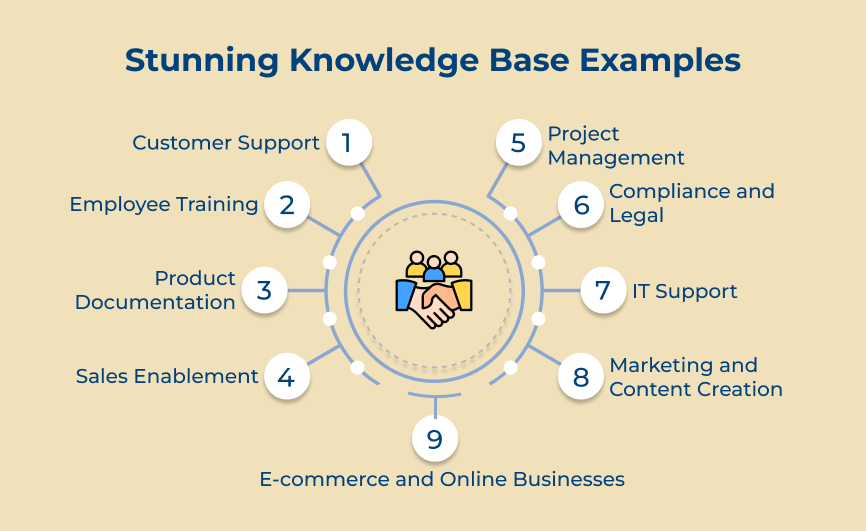
Customer Support is one of the top knowledge base use cases that effectively helps customers. 66% of customer service teams use knowledge bases. Well-designed knowledge bases empower customers by providing immediate access to relevant information. It enables them to find answers to their questions independently.
Let’s assume that a telecommunications company might maintain a knowledge base with articles covering common issues related to their services. It can include troubleshooting internet connectivity problems, setting up email accounts, or configuring wireless routers. Customers can access the resources anytime, anywhere and find solutions tailored to their specific needs.
Pro tips:
Employee Training is a best internal knowledge bases example that can significantly enhance an organization’s ability to develop and retain a skilled workforce. Well-designed knowledge bases for employee training helps by providing a centralized repository for training materials.
Let’s consider that a large retail chain might maintain a knowledge base with sections dedicated to product knowledge, customer service protocols and compliance policies. New hires can access the resources during their initial training. Experienced employees can refer to the knowledge base for refreshers or updates on company procedures and industry best practices.
Best practices:
A well-designed knowledge base for product documentation helps by serving as a centralized repository for user manuals, technical specifications, installation guides and FAQs. The approach ensures that stakeholders have access to accurate and up-to-date information. It enables them to better understand the product’s features, functionality and proper usage.
Let’s assume that a software development company might maintain a knowledge base with sections dedicated to product release notes, API documentation and tutorials. Customers and partners can reference the resources for self-service support. Internal teams can leverage the knowledge base to better understand the product.
How to implement:
Sales enablement is a crucial aspect of any successful sales operation. One top knowledge base example for sales enablement is a comprehensive sales playbook. A sales playbook is a centralized repository of information that provides sales reps with guidance on how to navigate the sales process and communicate the value of the offerings they are selling.
The importance of a sales playbook cannot be overstated. It not only helps new sales reps ramp up quickly but also serves as a valuable resource for experienced reps looking to improve performance.
One example of a successful use case for a sales playbook is a software company. It saw a significant increase in revenue after implementing a comprehensive sales playbook for its sales team.
Ways to implement:
Project Management is a top internal knowledge base example that can significantly enhance the efficiency, consistency and success of project execution across an organization. The approach ensures that project teams have easy access to standardized methodologies, best practices and insights from previous projects. .
Let’s consider that a consulting firm might maintain a knowledge base with sections dedicated to project initiation documents, communication protocols and post-project review templates. Project managers and team members can reference these resources throughout the project lifecycle. It helps in ensuring adherence to established processes and facilitating more effective project planning.
Best practices:
Compliance and legal knowledge bases are essential resources for companies looking to stay up-to-date on laws that affect their industry. The particular types of knowledge bases provide a central repository of information related to compliance requirements, legal obligations and best practices.
One of the main benefits of a compliance and legal knowledge base is that it helps companies mitigate risk by ensuring they are compliant with relevant laws.
Let’s assume that a knowledge base may contain information on data protection regulations, employee rights and industry-specific compliance requirements.
How to implement:
A well-designed knowledge base for IT support helps by providing a centralized repository for technical documentation, troubleshooting guides and best practices. The approach ensures that IT professionals have easy access to the information they need to quickly resolve various technical issues. It reduces downtime and improves productivity.
Let’s consider that a large enterprise might maintain a knowledge base with sections dedicated to software installations, network configurations, hardware troubleshooting and security protocols. IT support staff can reference these resources when addressing user requests. It enables them to provide timely solutions to common problems, minimizing the need for escalations.
Pro tips:
Marketing and Content Creation is a top knowledge base example that can significantly benefit organizations by streamlining their content development processes. It ensures that all materials and align with the company’s strategy. It helps in promoting a cohesive and professional brand image.
Let’s assume that a global consumer goods company might maintain a knowledge base with sections dedicated to brand identity guidelines, content calendars, and content creation templates. Marketing teams and content creators can easily access the resources. It helps in ensuring consistency across all marketing collateral and customer touchpoints.
Thing to consider:
A well-designed knowledge base assists e-commerce and online businesses by empowering customers with the information they need to make informed purchasing decisions. The self-service approach not only enhances customer satisfaction but also reduces the workload on support teams. It allows them to focus on more complex inquiries.
Let’s consider that an online retailer might maintain a knowledge base with sections dedicated to product descriptions, sizing guides, shipping and return policies. Customers can access the information at their convenience, ensuring they have an understanding of the offerings before purchasing
Pro tips:
Hey there! If you’re looking to provide a top-notch self-service experience for your customers, having a well-designed knowledge base is an absolute game-changer. But simply having a knowledge base isn’t enough – you need to make sure it’s user-friendly, comprehensive and easy to navigate. That’s where following some key best practices comes into play.
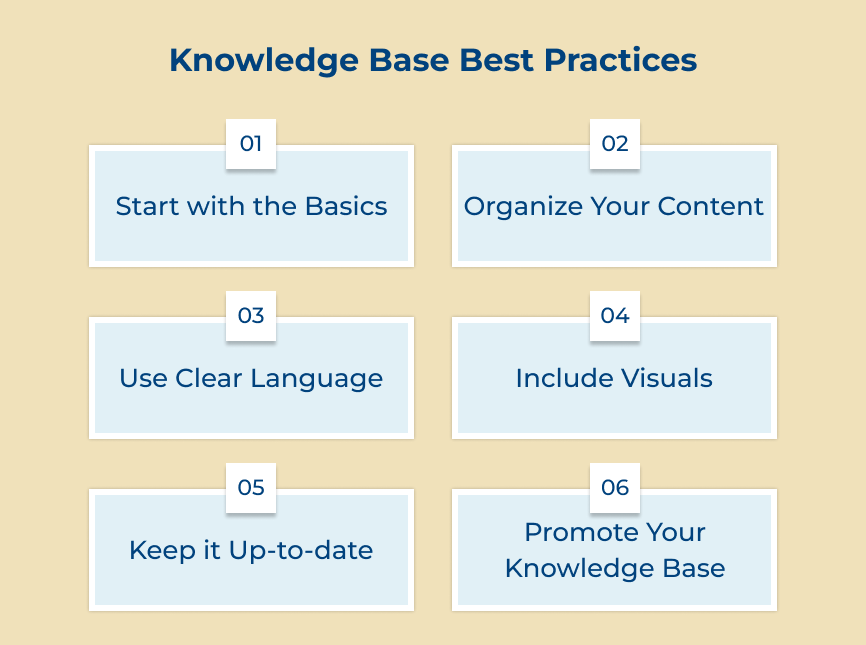
1. Start with the basics
Before diving into the nitty-gritty, let’s cover the fundamentals. Your knowledge base should be a one-stop-shop for all the information your customers might need. It should include product documentation to troubleshooting guides and FAQs. Think of it as a virtual library, but way cooler and more interactive.
2. Organize your content
Nobody likes feeling lost in a maze of information, so organization is key. Break down your table of content into logical categories and subcategories, making it easy for customers to find what they’re looking for. Use clear labels and don’t be afraid to get creative with tags or filters.
3. Use clear language
Remember, your customers come from all walks of life and may not be as technically savvy as you are. Keep your language simple, concise and free of jargon. Write as if you’re explaining things to a friend, not a rocket scientist. Trust me, your customers will appreciate the clarity.
4. Include visuals
They say a picture is worth a thousand words, and that’s especially true in a knowledge base. Incorporate visuals like screenshots, diagrams and videos to make complex concepts easier to understand. Not only does it make the content more engaging, but it also caters to different learning styles.
5. Keep it up-to-date
Nothing frustrates customers more than outdated information. Make sure your knowledge base stays fresh by regularly updating it with relevant content, fixes and product updates. Set reminders, assign team members to review articles and encourage customer feedback.
6. Promote your knowledge base
Your knowledge base is a valuable resource, so make sure your customers know it exists! Promote it on your website, include links in your email communication and train your team to direct customers to it. The more visible it is, the more likely customers are to use it and find the answers they need.
Many businesses have successfully implemented knowledge bases to improve customer satisfaction and reduce the strain on their support teams. Here are four real-life examples of businesses that have effectively implemented knowledge bases:
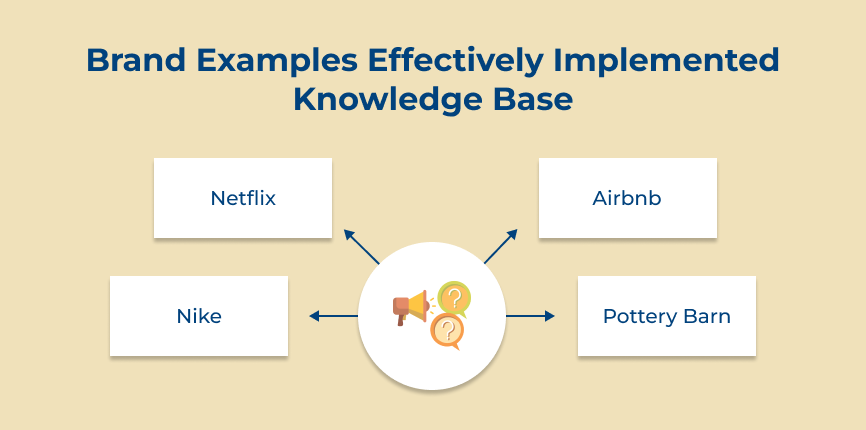
1. Nike
Nike, the multinational corporation known for its athletic footwear and apparel, has a comprehensive knowledge base on its website. The knowledge base covers a wide range of popular topics, from product information to sizing guides to returns and exchanges.
Nike’s knowledge base is user-friendly and easy to navigate, making it simple for customers to find the information they need. Nike has reduced the number of repetitive inquiries to its customer support team, by providing customers with easily accessible resources. It helped in improving the customer experience.
2. Netflix
Netflix, the popular streaming service, has a robust knowledge base that helps customers troubleshoot common issues and navigate the platform with ease. The knowledge base includes step-by-step guides for setting up accounts, managing profiles and resolving playback problems.
Netflix also provides FAQs and troubleshooting tips to address common technical issues. Netflix has decreased the burden on its support team by empowering customers to find knowledge base solutions on their own.
4. Airbnb
Airbnb, the online marketplace for vacation rentals, has a well-organized knowledge base that covers a wide range of topics related to booking and hosting properties. The knowledge base includes detailed guides on how to create listings, set pricing and communicate with guests.
Airbnb also provides resources on safety measures for hosts and guests. By offering comprehensive information in its knowledge base, Airbnb has empowered its users to resolve issues independently, by offering comprehensive information in its knowledge base. It resulted in quicker resolutions and happier customers.
5. Pottery Barn
Pottery Barn, the home furnishings retailer, has implemented a knowledge base to assist customers with product information, order tracking and returns. The knowledge base features articles on furniture care, design inspiration and gift ideas.
Pottery Barn’s knowledge base is visually appealing and easy to navigate, making it a valuable resource for customers seeking assistance. Pottery Barn has enhanced the customer experience by providing a wealth of information in its knowledge base.
Knowledge base tools are essential for businesses looking to streamline their communication, improve customer support and increase productivity. Here are five popular knowledge base softwares along with an overview of each, their features and pricing options:
Veemo is a leading knowledge base software that provides businesses with a centralized platform to store, manage and share information. It is designed to help companies improve customer service, increase efficiency and streamline communication processes.
Key features:
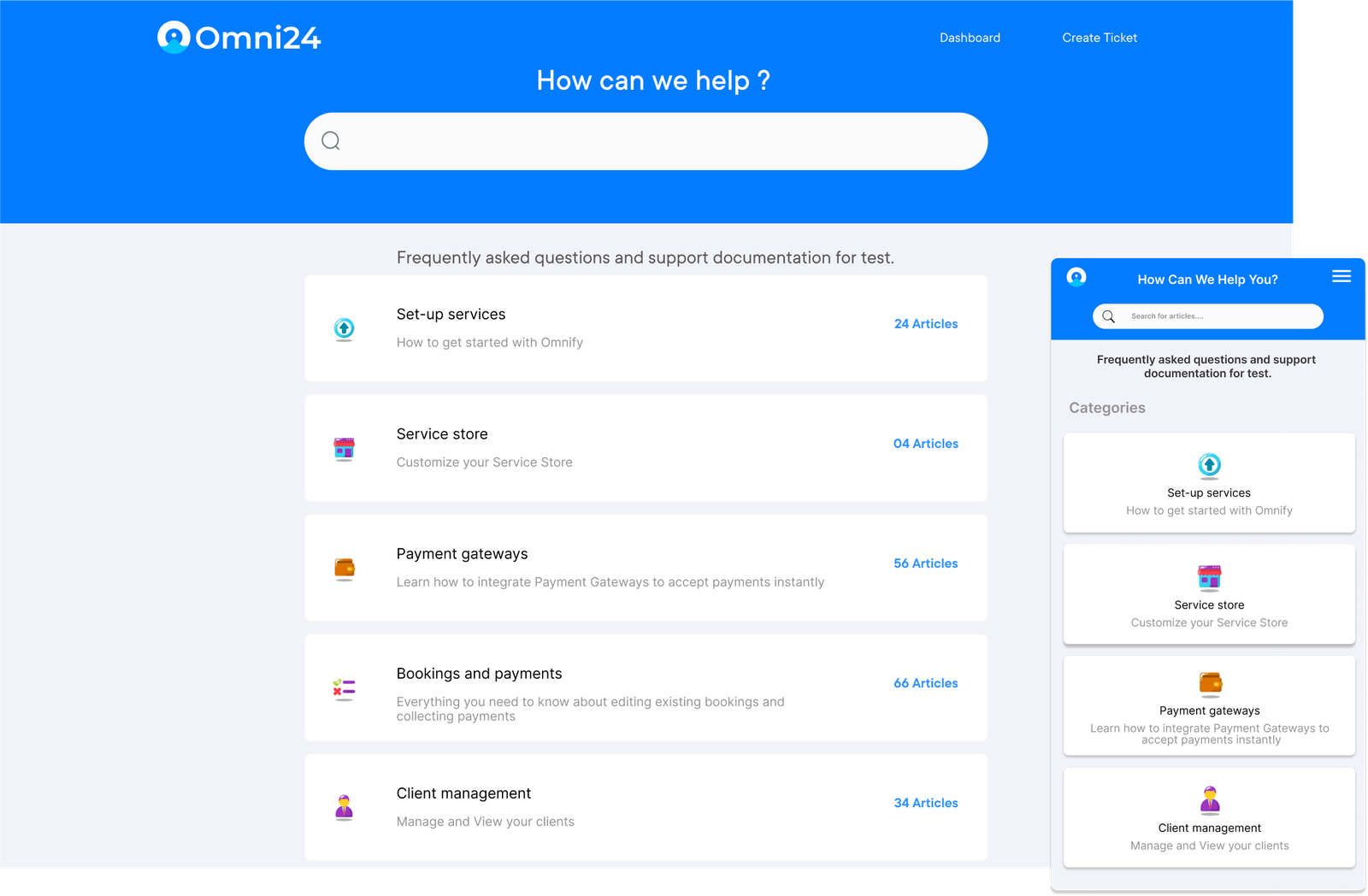
Omni24’s knowledge base software offers a user-friendly interface that allows businesses to create and customize their knowledge base to fit their specific needs. Features such as categorization, search functionality and analytics can help businesses ensure that their customers have access to the information they need at all times.
Key features:
Zendesk Guide is a cloud-based knowledge base software that helps businesses create and maintain a self-service support portal for their customers. It offers features such as article knowledge management, analytics and integrations with various third-party apps. Pricing starts at $1 per agent per month for the Lite plan, with higher-tier plans available for additional features.
Document360 is a knowledge base software that helps businesses publish documentation for internal and external use. It offers features such as multi-language support, customization options, analytics and integrations. Pricing starts at $49 per month for the Basic plan, with higher-tier plans available for additional features.
ProProfs Knowledge Base is a knowledge base software that helps businesses create and manage online help documentation. It offers features such as content creation, customization options, analytics and integrations with popular tools like Zendesk. Pricing starts at $39 per month for the Essential plan, with higher-tier plans available for additional features.
Unlocking endless possibilities with knowledge base examples is crucial for success in digital marketing. Utilizing practical examples and case studies can help professionals learn how to effectively implement strategies in their own campaigns. The real-world examples provide valuable insights and guidance, allowing marketers to stay ahead of the curve.
Individuals can confidently navigate the complex and ever-evolving landscape of digital marketing with a solid foundation of internal knowledge base examples. So, whether you’re just starting out or looking to enhance your skills, harnessing the power of knowledge base examples is key to achieving success.
A good knowledge base is comprehensive, organized and easy to navigate. It should have clear, concise information that is regularly updated to reflect changes and address common questions. A good knowledge base should have search functionality and be accessible across multiple devices.
A knowledge-based business is one that generates revenue primarily through the sale of intellectual property, such as software, education, or consulting services. An example of a knowledge-based business would be a software company that develops and sells technology solutions to businesses or individuals. The particular types of businesses rely on the expertise and information they possess to create value for their customers.
Include data on company policies, procedures, employee contact information, project updates and relevant industry news. Incorporate training materials, troubleshooting guides and best practices to help employees solve issues independently. Include customer feedback, sales data and market research to inform decision-making. Keep information up-to-date and easily accessible for all team members.
One example of the importance of knowledge is in the medical field. Doctors rely on years of education to accurately diagnose and treat patients. Without the necessary knowledge, medical professionals would struggle to provide effective care, leading to potential harm or even death for patients. Knowledge in the particular context is crucial for saving lives and improving health outcomes.
One example of a knowledge base AI is IBM Watson. Watson is a question-answering computer system capable of answering questions posed in natural language. It uses a vast amount of data and information stored in its knowledge base to provide accurate answers to inquiries. Watson has been used in various industries, including healthcare, finance and customer service.

Market better, sell faster and support smarter with Veemo’s Conversation Customer Engagement suite of products.
Unify all your customer data in one platform to deliver contextual responses. Get a 360 degree view of the customer lifecycle without switching tools.
Connect with the tools you love to reduce manual activities and sync your business workflows for a seamless experience.
 https://veemo.io/wp-content/uploads/2024/12/customer-service-response-time.png
1256
2400
Webvision Solution
https://veemo.io/wp-content/uploads/2024/11/veemo.svg
Webvision Solution2025-10-17 10:51:142025-10-17 10:51:149 Effective Tips to Reduce Customer Service Response Time
https://veemo.io/wp-content/uploads/2024/12/customer-service-response-time.png
1256
2400
Webvision Solution
https://veemo.io/wp-content/uploads/2024/11/veemo.svg
Webvision Solution2025-10-17 10:51:142025-10-17 10:51:149 Effective Tips to Reduce Customer Service Response Time https://veemo.io/wp-content/uploads/2024/06/Customer-Communication-Best-Practices1.png
628
1200
Vikas Sachan
https://veemo.io/wp-content/uploads/2024/11/veemo.svg
Vikas Sachan2024-11-05 06:43:042024-11-05 06:43:04Top 15 Customer Communication Best Practices for Businesses
https://veemo.io/wp-content/uploads/2024/06/Customer-Communication-Best-Practices1.png
628
1200
Vikas Sachan
https://veemo.io/wp-content/uploads/2024/11/veemo.svg
Vikas Sachan2024-11-05 06:43:042024-11-05 06:43:04Top 15 Customer Communication Best Practices for Businesses https://veemo.io/wp-content/uploads/2024/02/Live-Chat-for-Sales.png
628
1200
teamwebvisionsolution@gmail.com
https://veemo.io/wp-content/uploads/2024/11/veemo.svg
teamwebvisionsolution@gmail.com2024-10-21 11:31:222025-08-06 10:22:06How to Use Live Chat for Sales? 7 Proven Ways to Grow Revenue
https://veemo.io/wp-content/uploads/2024/02/Live-Chat-for-Sales.png
628
1200
teamwebvisionsolution@gmail.com
https://veemo.io/wp-content/uploads/2024/11/veemo.svg
teamwebvisionsolution@gmail.com2024-10-21 11:31:222025-08-06 10:22:06How to Use Live Chat for Sales? 7 Proven Ways to Grow RevenueGrow Customer Relationships and stronger team collaboration with our range of products across the Conversational Engagement Suite.

 How to Improve First Contact Resolution with 7 Tips
Scroll to top
How to Improve First Contact Resolution with 7 Tips
Scroll to top